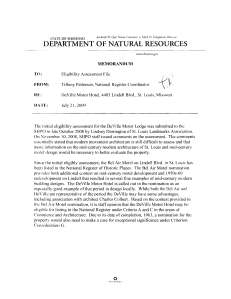On June 22nd certain members of the Preservation Board questioned whether the DeVille Motor Hotel could be listed upon the National Register of Historic Places. Proponents for preservation cited the State of Missouri’s Historic Preservation Office’s November 2008 staff comments, in response to an eligibility assessment performed by Landmarks Association, indicating the building would be eligible. SPHO revised their findings, yet did not submit them to the Preservation Board. Given SPHO’s revised assessment, even under their original November 2008 findings, the DeVille Motor Hotel must be considered Qualifying under the Preservation Board Enabling Ordinance. If it were individually listed upon the National Register, as the Bel Air was in May of 2009, this building would be considered High Merit. These buildings are not to be demolished:
“High Merit” means contributing as a major structure to an existing or potential City or national historic district; or, deserving of consideration for single site historic or Landmark Site designation.
Demolition of Sound High Merit Structures shall not be approved by the Office…Merit or Qualifying Structures shall not be approved except in unusual circumstances which shall be expressly noted.
Local ordinances were violated, while the Preservation Board appeals process does not halt demolition while the appeal actually occurs, therefore Friends of the San Luis took legal action in order to prevent demolition. Unfortunately our judge denied this request. He also ruled against the DeVille on July 24th. Notably, ultra-conservative Judge Robert H. Dierker has experience in these matters:
The Syndicate Trust-Century Building is a “deteriorating, dangerous hulk squatting in the heart of downtown St. Louis” and needs to come down almost immediately, [Circuit Judge Robert H. Dierker Jr.] ruled Thursday… [Dierker] gave the city and the building’s owner 30 days to submit a demolition plan. “Dierker said the Syndicate Trust-Century is too far gone to save. It “is a derelict, full of rubbish and literally falling apart inside and out,” he wrote.
“The record is equally clear that there is no way on earth to rehabilitate the building to put it to an economically viable use,” the judge said. “There is not a scintilla of evidence that anyone . . . could obtain a fraction of the financing to rehabilitate the buildings….”(Post Dispatch, 9/14/2000).
The purpose of these local ordinances, which seek preservation of our irreplaceable architectural resources, are evident within the Preservation Board Enabling Ordinance:
The intent of this ordinance is to promote the prosperity and general welfare of the public, including particularly the educational and cultural welfare, through:
- A. The protection, enhancement, perpetualion and use of buildings, improvements, parks, sites and natural phenomena as have or may reasonably be expected to have historic or cultural value and significance to the nation, the state or the City;
- B. The stabilization and improvement of the value of property and the equity held by citizens in their property by the enhancement of the beauty, convenience and amenity of neighborhoods, parks, streets, public buildings and monuments, and by the enhancement of civic design;
- C. The increase of economic resources available for the conservation and rehabilitation of neighborhoods and for the abatement of blight by the encouragement and use of public financial assistance and tax benefits available for the reuse of buildings, neighborhoods and public facilities with primary emphasis on making said resources available to City residents, property owners who by virtue of limited income might otherwise be unable to maintain their property, property owners whose property is not producing a reasonable income, and potential investors in property located in the City;
- D. The increase of commerce and prosperity by the protection of the value, convenience, and amenity of property and to promote the tourist trade and civic pride and wider public knowledge and appreciation of the heritage and history of St. Louis.
As the demolition of the DeVille Motor Hotel progress, citizens must realize that the same mechanisms — State and Federal Historic Tax Credits — which led to the rehabilitation of the Chase Park Plaza, Coronado, the Continental Life Building, and the recently opened Bel Air, would have led to the revitalized DeVille Motor Hotel. Developer Steve Anrod, known locally for Blue City Spaces and the Park East Tower, expressed strong desire in rehabilitation. City residents must also recognize that this demolition violates not only the expressed intent of the Preservation Board Enabling Ordinance, but individual criteria that determine which buildings (as the intent states) have or may reasonably be expected to have historic or cultural value and significance to the nation, the state or the City. Demolition approval renders these ordinances inane, thus subjecting future threatened buildings to the political vogue of the day.
Dierker’s ruling — that citizens have no standing to appeal matters of the Preservation Board to Circuit Court — overrides the Enabling Ordinance’s intent. Through Dierker, the Mayoral Appointed Preservation Board empowers itself, making arbitrary decisions absent ordinance enumerated rubric, without redress available through the Preservation Board appeal process or the Courts. If this ruling stands then citizens have absolutely no legal basis for demolition objection. With such an abdication of the democratic process — through the denial of ordinances enacted by our elected Board of Aldermen — citizen-stakeholder concern becomes inane at the detriment of neighborhoods citywide. With empowered special interests, beholden elected officials, and suppressed citizens, our built environment will not survive.
The DeVille Motor Hotel — a building of expressly high reuse potential and architectural significance under the law — shouldn’t suffer such a wasteful fate. If not for the malleable interpretation of City ordinance, and political enfeeblement of elected officials, martinis and tourists (simultaneously the parked cars of Rosati-Kain students) could be common at Lindell and Taylor.
Douglas Duckworth
Friends of the San Luis
566-3465


Pingback: Prevention through Legislation « No Parking Lot on Lindell!